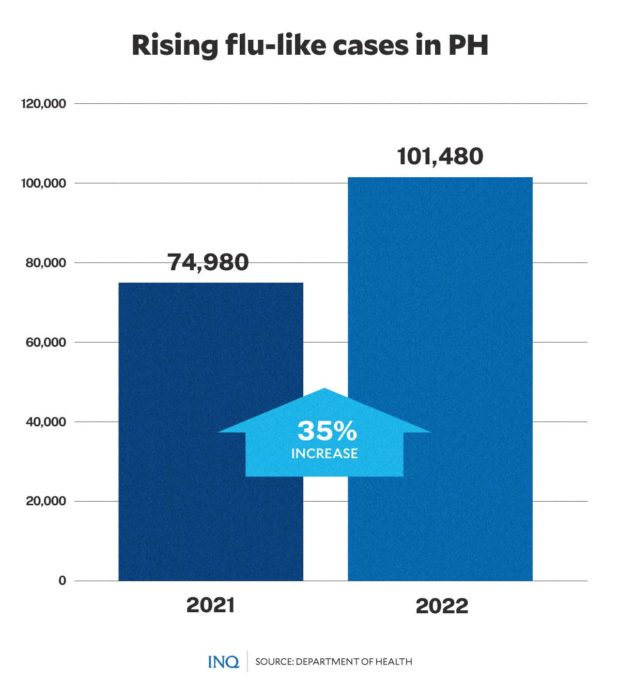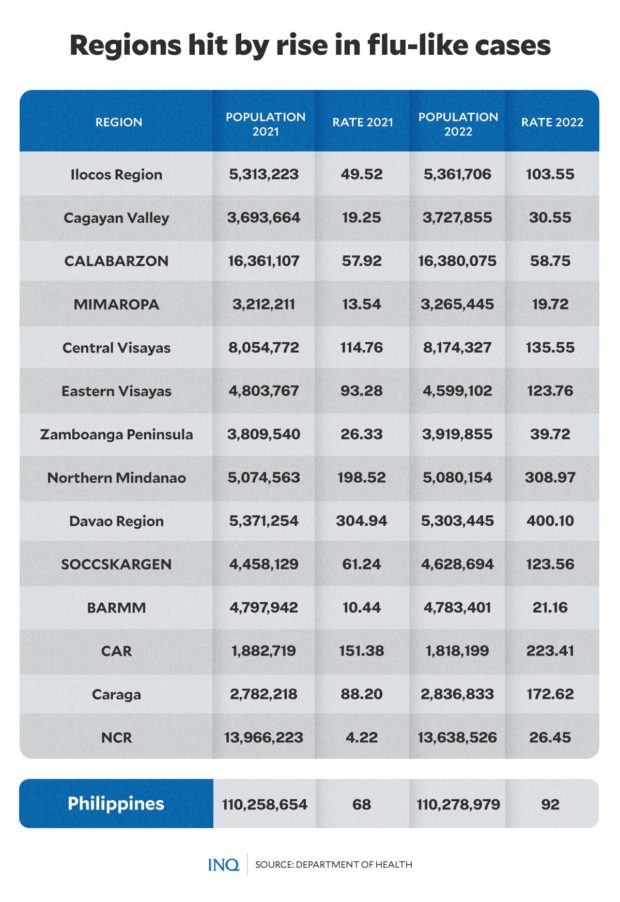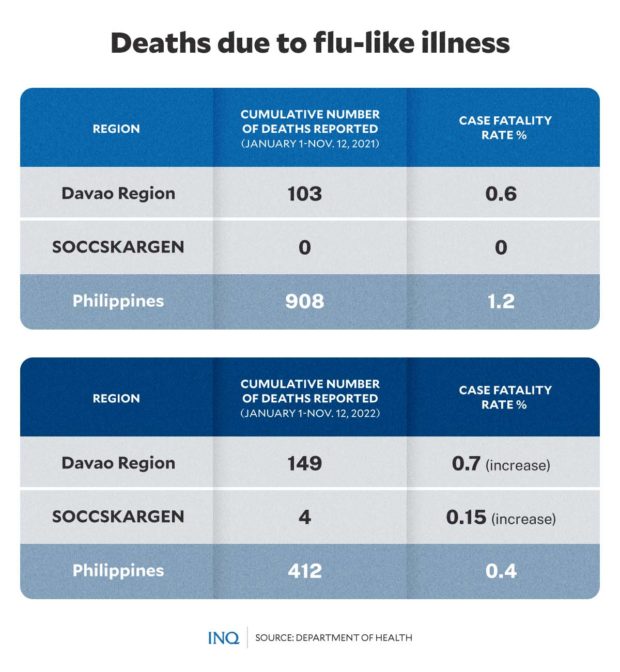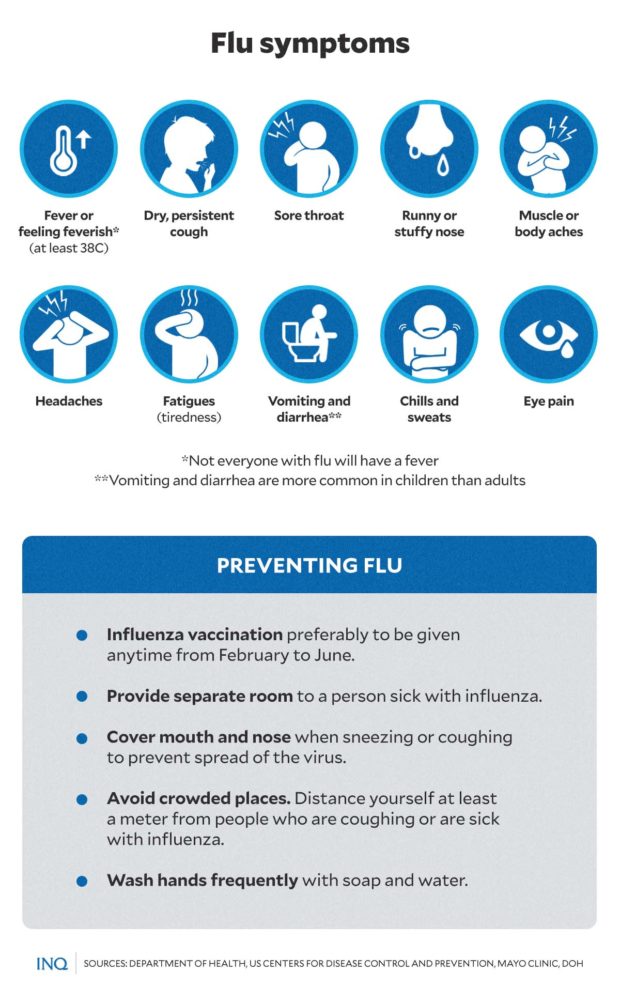As flu cases rise 500% in NCR, warning signs light up during holidays
MANILA, Philippines—Amid celebrations and parties during the holiday season, health experts cautioned against cases of seasonal influenza, which in several countries has been increasing and causing a spike in hospital admissions.
Seasonal influenza, according to World Health Organization (WHO), is “an acute respiratory infection caused by influenza viruses which circulate in all parts of the world.” In severe cases, it can lead to hospitalization and death.
Although WHO described seasonal influenza as a year-round disease burden, in some areas across the globe, it is more common during the cold season or winter—which mostly coincides with the holiday season.
“It represents a year-round disease burden. It causes illnesses that range in severity and sometimes lead to hospitalization and death,” WHO added.
Earlier this month, the Philippine health department warned Filipinos of possible health hazards that are common during the holiday season, like influenza.
Article continues after this advertisement“We have a trend of illnesses or a season of illness. Whenever the weather changes in the Philippines—dry then rainy or hot then cold—it is because Ber months are already here, like this month of December,” said Health Undersecretary Maria Rosario Vergeire, officer-in-charge of the Department of Health (DOH).
Article continues after this advertisement“Incidents of flu rise, these are influenza, cases of pneumonia, or worsened flu,” Vergeire added.
READ: Take caution during season of illness – DOH
Influenza-like cases going up
At a media forum last December 20, Vergeire once again warned against influenza, noting an uptick in cases recorded since last November due to the rainy season.
“This month of December — it started even last November — cases of other diseases like influenza or what we call flu, and WILD diseases increased because of the past rainy season,” she said.
“We see that people get flu, and based on trends, it comes during ‘ber’ months. Our cases of flu or flu-like symptoms increase, and this, primarily, is because of the change in weather,” she added.
READ: Cases of flu, water-borne infectious diseases up since November —DOH
Data from the DOH’s Epidemic-prone Disease Case Surveillance report showed that cases of influenza-like illness (ILI) or flu increased by 35 percent from 74,980 in January 1 to November 12 last year to 101,480 cases recorded during the same period this year.
The highest increase in ILI cases this year was recorded in the National Capital Region (NCR), with 3,607 cases—around 500 percent higher than the 589 cases recorded in 2021.
It is followed by the Ilocos Region, which saw a 111 percent increase in its number of ILI cases from 2,631 last year to 5,552 this year. SOCCSKARGEN (South Cotabato, Cotabato, Sultan Kudarat, Sarangani, and General Santos City), BARMM (Bangsamoro Autonomous Region in Muslim Mindanao), and the Caraga Region also documented a huge jump in ILI cases this year—109 percent, 102 percent, and 100 percent, respectively.
The report also noted an increase in terms of the incidence rate of ILI cases per 100,000 population in the country. From a 68 percent incidence rate in the first 11 months of 2021, the numbers rose to 92 percent during the same period this year.
Although the number of deaths due to ILI went down to 412 this year compared to 908 in 2021—and the case fatality rate of ILI in the country fell from 1.2 percent to 0.4 percent—fatalities caused by influenza increased in some regions.
In Davao Region, the case fatality rate for ILI shot up from 0.6 percent (103 deaths) to 0.7 percent (149 deaths) this year. The case fatality rate in SOCCSKARGEN went from zero last year to 0.15 percent this year with four ILI-related deaths.
Spike in child hospitalization
According to WHO and the US Centers for Disease Control and Prevention (CDC), influenza is common among children and the elderly. It can also cause severe illness or even death among high risk groups.
In Canada, health experts and patients expressed concerns over the recent climb in pediatric hospitalizations due to seasonal influenza, which was reported to be around 10 times higher than the normal rate for this time of the year.
A report published by Nature cited Alyson Kelvin, a virologist at the Vaccine and Infectious Disease Organization at the University of Saskatchewan in Saskatoon, Canada, who said the younger population is being hit “unusually hard” this time of the year.
“It’s concerning to see this many hospitalizations. There’s [still fewer] than five pediatric deaths reported [in Canada], which I think is standard for a whole season—but we’re only entering the season at this point,” Kelvin continued.
The report also noted that flu cases among the younger age groups has also been high in the United States. However, there has not been rapid rise detected yet in US pediatric hospitalizations or fatalities due to flu.
Robert Ware, a clinical epidemiologist at Griffith University in Queensland, Australia, explained that among the possible uptick in flu cases this year could be driven by an “immunity deficit” caused by the lack of exposure to seasonal influenza during the COVID-19 pandemic.
According to the Nature article, the flu “largely disappeared” at the height of the pandemic following the imposition of non-pharmaceutical interventions such as mask wearing, school closures and social distancing which also helped stop transmission of influenza viruses.
However, as countries across the globe slowly loosen these measures, cases of seasonal flu are expected to rise once again and bounce back.
READ: Merriest yet deadliest: Knowing and preventing holiday hazards
Flu symptoms, prevention
Among the symptoms of flu, according to the US CDC, were:
- fever or feeling feverish (at least 38C)
- dry, persistent cough
- sore throat
- runny or stuffy nose
- muscle or body aches
- headaches
- fatigues (tiredness)
- vomiting and diarrhea
- chills and sweats
- eye pain
Some of these symptoms are, however, similar to symptoms of COVID-19—particularly coughing, sore throat, and fever.
READ: Is that flu or COVID? Hard to tell by symptoms alone – DOH
“The symptoms are generally similar for COVID-19 infection whether Delta or Omicron variant, or even with regular flu,” the DOH previously said. “So, once you have symptoms, it is best to test to confirm what you have.”
The DOH also recommended the following measures to prevent getting infected with the flu.
- Influenza vaccination preferably to be given anytime from February to June.
- Provide separate room to a person sick with influenza.
- Cover mouth and nose when sneezing or coughing to prevent spread of the virus.
- Avoid crowded places. Distance yourself at least a meter from people who are coughing or are sick with influenza.
- Wash hands frequently with soap and water.
TSB
For more news about the novel coronavirus click here.
What you need to know about Coronavirus.
For more information on COVID-19, call the DOH Hotline: (02) 86517800 local 1149/1150.
The Inquirer Foundation supports our healthcare frontliners and is still accepting cash donations to be deposited at Banco de Oro (BDO) current account #007960018860 or donate through PayMaya using this link.




